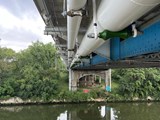Maintaining a suspended pipeline requires trained crews, expert project management, extra safety considerations, and flawless project execution.
Maintaining Suspended Pipelines
Bridges carry more than just cars or trucks. Electric lines, fiber-optic cables, and pipelines can also be found suspended from bridge structures. This case study describes a Midwestern Contractors (MWC) maintenance project on two 300-foot pipeline spans, suspended from a bridge.
Pipelines suspended in this manner are subject to forces different than those exerted in underground installations. Suspended pipelines flex and move with the movement of the bridge. The suspended pipeline also moves with respect to the vertical risers on each end. Further the exposed pipe is subject to the direct effects of temperature extremes, humidity, and road salt.
PROJECT NOTES
1 12" line 300' span
1 16" line 300' span
Coating 33 gallons of 3 part Sherwin Williams Macropoxy
Glass blast media
A further complication is added with the supporting hardware and rollers. This hardware is subject to corrosion and mechanical forces transmitted by a moving pipe filled with crude oil or distilled products moving through the pipeline under high pressure. A thorough inspection and, in some cases, the use of NDT, will assure the integrity of this hardware.
Maintaining a suspended pipeline and attachment hardware starts with an inspection of the bridge and assessment of the condition of the pipe and hangers. Permits must be obtained and usually barges and towboats are used for positioning the crew. If this is the case a notice to mariners must be published and the towboat captain must coordinate with all passing traffic. Thorough project management and risk management is necessary. A detailed safety plan must account for aerial work, overwater work, and injuries that could occur when the barge is mid-channel and cannot immediately get to shore.
During this project, the barge was moved by a towboat and positioned under the bridge deck. The barge was preloaded with man-lifts, welding machines, air compressor and sand blast equipment, and small tools. The barge was then towed to the worksite and pinned in place by spuds lowered into the soft bottom of the canal. Two pipelines were to be maintained and painted. A 12 inch on one side and a 16 inch on the other. Work proceeded simultaneously on each pipe. One pipe was ARO coated and only required brush blasting before coating. Where the other was blasted to bare metal. Environmentally friendly blast medium was used. After blasting 33 gallons of three-part Sherwin-Williams Macro-Poxy coating was applied in stages.
The use of man-lifts allows for a remarkably close inspection of all bridge hangers and rollers. All chafing gear was also inspected. All rollers and axles were replaced. Man-lifts were also used to inspect, maintain and paint the areas close to the bridge abutments where the risers were located.
Sandblasting creates dust, paint chips, and blast medium waste. This material was collected by using tarps on the barge deck. The waste material was placed in drums for disposal in a landfill.
This type of maintenance project is complicated by working over water. However, with good planning, crew training, and final execution this project was completed in four weeks with zero safety incidents.
Midwestern Contractors has had decades of experience with pipeline maintenance of all types, underground, aerial, integrity, and valve work. MWC can help you with relocations, pipeline lowering, exposed pipelines and complex station work. If you wish to talk to one of our project managers, please click on Request a Project or call Mike Purpura at 630-936-3282.













